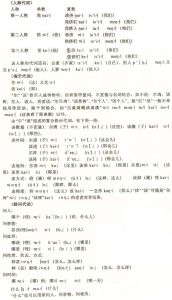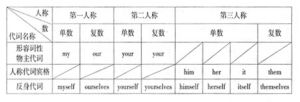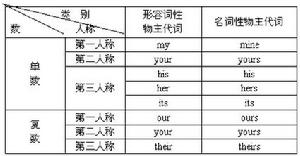 代詞
代詞代詞總介
一、人稱代詞是表示“我”、“你”、“他”、“她”、“它”、“我們”、“你們”、“他們”的詞。
人稱代詞有人稱、數和格的變化,見下表:
數單數 複數
格主格 賓格 主格賓格
第一人稱 I me we us
第二人稱 youyou you you
he him they them
第三人稱 sheher they them
it it they them
如:He is my friend. 他是我的朋友。
It's me. 是我。
二、 物主代詞表示所有關係的代詞,也可叫做代詞所有格。物主代詞分形容性物主代詞和名詞性物主代詞二種,其人物和數的變化見下表。
數 單數 複數
人稱 第一 第二 第三 第一 第二 第三
人稱 人稱 人稱 人稱 人稱 人稱
形容詞性 my your his/her/its our your their
物主代詞
名詞性 mine yours his/hers/its ours yours theirs
物主代詞
如: I like his car.我喜歡他的小汽車。
Our school is here,and theirs is there. 我們的學校在這兒,他們的在那兒。
 詞形速記表
詞形速記表 名詞性物主代詞
名詞性物主代詞三、 指示代詞表示“那個”、“這個”、“這些”、“那些”等指示概念的代詞。
指示代詞有this,that,these,those等。
如: That is a good idea. 那是個好主意。
四、 表示“我自己”、“你自己”、“他自己”、“我們自己”、“你們自己”和“他們自己”等的代詞,叫做自身代詞,也稱為“反身代詞”。
如: She was talking to herself. 她自言自語。
五、 表示相互關係的代詞叫相互代詞,有each other 和one another兩組,但在運用中,這兩組詞沒什麼區別。
如: They love each other.他們彼此相愛。
六、 不是指明代替任何特定名詞的代詞叫做不定代詞。
常見的不定代詞有a11,both,each,every等,以及含有some-,any-,no-等的合成代詞,如anybody, something,no one。這些不定代詞大都可以代替名詞和形容詞,在句中作主語、賓語、表語和定語,但none和由some,any,no等構成的複合不定代詞只能作主語、賓語或表語;every和no只能作定語。如:
--- Do you have a car? --你有一輛小汽車嗎?
--- Yes,I have one.--是的,我有一輛。
--- I don't know any of them. 他們,我一個也不認識。
七、 疑問代詞有who,whom,whose,what和which等。在句子中用來構成特殊疑問句。疑問代詞都可用作連線代詞,引導名詞性從句(主語從句、賓語從句和表語從句)
如:Tell me who he is. 告訴我他是誰。
八、 關係代詞有who,whom,whose,that,which,as等,可用作引導從句的關聯詞。
它們在定語從句中可作主語、表語、賓語、定語等;另一方面它們又代表主句中為定語從句所修飾的那個名詞或代詞(通稱為先行詞)。
如: He is the man whom you have been looking for. 他就是你要找的那個人。
人稱代詞的用法
1)人稱代詞的主格在句子中作主語或主語補語,例如:
John waited a while but eventually he went home.
約翰等了一會兒,最後他回家了。
John hoped the passenger would be Mary and indeed it was she.
約翰希望那位乘客是瑪麗,還真是她。
說明:在複合句中,如果主句和從句主語相同,代詞主語要用在從句中,名詞主語用在主句中,例如:
When he arrived, John went straight to the bank.
約翰一到就直接去銀行了。
2)人稱代詞的賓格在句子中作賓語或介詞賓語,但在口語中也能作主語補語,第一人稱在省略句中,還可以作主語,例如:
I saw her with them, at least, I thought it was her.
我看到她和他們在一起,至少我認為是她。(her做賓 語,them做介詞賓語,her做主語補語)
a. -- Who broke the vase? --誰打碎了花瓶?
b. -- Me.--我。(me做主語補語= It's me.)
說明:在上面兩例句中,her和me分別作主語補語。現代英語中多用賓格,在正式文體中這裡應為she和I。
人稱代詞之主、賓格的替換
1) 賓格代替主格
a.在簡短對話中,當人稱代詞單獨使用或在not 後,多用賓語。
---- I like English. --我喜歡英語。
---- Me too. --我也喜歡。
---- Have more wine? --再來點酒喝嗎?
---- Not me. --我可不要了。
b.在表示比較的非正式的文體中,常用賓格代替主格。 但如果比較狀語的謂語保留,則主語只能用主格。
He is taller than I/me.
He is taller than I am.
2) 主格代替賓格
a. 在介詞but,except 後,有時可用主格代替賓格。
b. 在電話用語中常用主格。
---- I wish to speak to Mary. --我想和瑪麗通話。
---- This is she. --我就是瑪麗。
注意:在動詞be 或to be 後的人稱代詞視其前面的名詞或代詞而定。
I thought it was she. 我以為是她。(主格----主格)
I thought it to be her. (賓格----賓格)
I was taken to be she.我被當成了她。(主格----主格)
They took me to be her. 他們把我當成了她。 (賓格----賓格)
代詞的指代問題
1)不定代詞 anybody,everybody,nobody,anyone, someone, everyone,no one, 及whoever和person在正式場合使用時,可用he, his, him代替。
Nobody came, did he? 誰也沒來,是嗎?
2)動物名詞的指代一般用it或they代替,有時也用he, she,帶有親切的感情色彩。
Give the cat some food. She is hungry. 給這貓一些吃的。她餓了。
3)指代車或國家,船舶的名詞,含感情色彩時常用she。
並列人稱代詞的排列順序
1) 單數人稱代詞並列作主語時,其順序為:
第二人稱 -> 第三人稱 -> 第一人稱
you -> he/she; it -> I
You, he and I should return on time.
2) 複數人稱代詞作主語時,其順序為:
第一人稱 -> 第二人稱 -> 第三人稱
we -> you -> They
注意: 在下列情況中,第一人稱放在前面。
a. 在承認錯誤,承擔責任時,
It was I and John that made her angry.
是我和約翰惹她生氣了。
b. 在長輩對晚輩,長官對下屬說話時,如長官為第一人稱, 如:I and you try to finish it.
c. 並列主語只有第一人稱和第三人稱時,
d. 當其他人稱代詞或名詞被定語從句修飾時。
物主代詞
1)物主代詞既有表示所屬的作用又有指代作用,例如:
John had cut his finger; apparently there was a broken glass on his desk.
約翰割破了手指,顯而易見,他桌子上有個破玻璃杯。
物主代詞有形容詞性(my, your等)和名詞性(mine, yours等)兩種,形容詞性的物主代詞屬於限定詞。
名詞性的物主代詞在用法上相當於省略了中心名詞的 --'s屬格結構,例如:
 代詞
代詞His cap 意為 The cap is his.
2) 名詞性物主代詞的句法功能
a. 作主語,例如:
May I use your pen? Yours works better.
我可以用一用你的鋼筆嗎? 你的比我的好用。
b. 作賓語,例如:
I love my motherland as much as you love yours.
我愛我的祖國就像你愛你的祖國一樣深。
c. 作介詞賓語,例如:
Your should interpret what I said in my sense of the word, not in yours.
你應當按我所用的詞義去解釋我說的話,而不能按你自己的意義去解釋。
d. 作主語補語,例如:
The life I have is yours. It's yours. It's yours. 我的生命屬於你,屬於你,屬於你。
雙重所有格
物主代詞不可與 a, an, this, that, these, those, some, any, several, no, each, every, such, another, which等詞一起前置,修飾一個名詞,而必須用雙重所有格。
公式為:
a, an, this, that +名詞+of +名詞性物主代詞。如:
a friend of mine.
each brother of his.
反身代詞
1) 列表
I you you she he
myself yourself yourselves herself himself
we they itone
ourselves themselves itselfoneself
2)做賓語
a. 有些動詞需有反身代詞
absent, bathe, amuse, blame, dry, cut, enjoy, hurt, introduce, behave
We enjoyed ourselves very much last night. 我們昨晚玩得很開心。
Please help yourself to some fish. 請你隨便吃點魚。
b. 用於及物動詞+賓語+介詞
take pride in, be annoyed with, help oneself to sth.
I could not dress (myself) up at that time. 那個時候我不能打扮我自己。
註:有些動詞後不跟反身代詞, get up, sit-down, stand up, wake up等。
Please sit down. 請坐。
be oneself: I am not myself today. 我今天不舒服。
The thing itself is not important.事情本身並不重要。
4) 在不強調的情況下,but, except, for 等介詞後賓語用反身代詞或人稱代詞賓格均可。如:
No one but myself (me) is hurt.
注意:
a. 反身代詞本身不能單獨作主語。
(錯) Myself drive the car.
(對) I myself drive the car. 我自己開車。
b. 但在and, or, nor連線的並列主語中,第二個主語可用反身代詞,特別是myself 作主語。
Charles and myself saw it.
5)第二人稱作賓語,要用反身代詞。
You should be proud of yourself. 你應為自己感到驕傲。
相互代詞
1)相互代詞只有each other和one another兩個詞組。他們表示句中動詞所敘述的動作或感覺在涉及的各個對象之間是相互存在的,例如:
It is easy to see that the people of different cultures have always copied each other.
顯而易見,不同文化的人總是相互借鑑的。
2) 相互代詞的句法功能:
a. 作動詞賓語;
People should love one another. 人們應當彼此相愛。
b. 可作介詞賓語;
Does bark, cocks crow, frogs croak to each other. 吠、雞鳴、蛙兒對唱。
說明:傳統語法認為,相互關係存在於兩個人或物之間用each other, 存在於兩個以上人和物之間用one another。現代英語中,兩組詞交替使用的實例也很多,例如:
He put all the books beside each other.
他把所有書並列擺放起來。
He put all the books beside one another.
他把所有書並列擺放起來。
Usually these small groups were independent of each other.
這些小團體通常是相互獨立的。
c. 相互代詞可加-'s構成所有格,例如:
The students borrowed each other's notes.
學生們互借筆記。
指示代詞
1) 指示代詞分單數(this / that)和複數(these / those)兩種形式,既可作限定詞又可做代詞,例如:
單數複數
限定詞:This girl is Mary.Those men are my
teachers.
代詞: This is Mary. Those are my
teachers.
2) 指示代詞的句法功能;
a. 作主語
This is the way to do it.
這事兒就該這樣做。
b. 作賓語
I like this better than that.
我喜歡這個甚至那個。
c. 作主語補語
My point is this.
我的觀點就是如此。
d. 作介詞賓語
I don't say no to that.
我並未拒絕那個。
There is no fear of that.
那並不可怕。
說明1:
指示代詞在作主語時可指物也可指人,但作其他句子成分時只能指物,不能指人,例如:
(對)That is my teacher. 那是我的老師。( that作主語,指人)
(對)He is going to marry this girl. 他要和這個姑娘結婚。(this作限定詞)
(錯)He is going to marry this. (this作賓語時不能指人)
(對)I bought this. 我買這個。(this指物,可作賓語)
說明2:
That和those可作定語從句的先行詞,但this和 these不能,同時,在作先行詞時,只有those可指人,試比較:
(對) He admired that which looked beautiful. 他讚賞外表漂亮的東西。
(對) He admired those who looked beautiful. 他讚賞那些外表漂亮的人。(those指人)
(錯) He admired that who danced well. (that作賓語時不能指人)
(對) He admired those who danced well. 他讚賞跳舞好的人。(those指人)
(對) He admired those which looked beautiful. 他讚賞那些外表漂亮的東西。(those指物)
疑問代詞
1) 疑問代詞在句中起名詞詞組的作用,用來構成疑問句。疑問代詞有下列幾個:
指 人: who, whom, whose
指 物: what
既可指人又可指物: which
2) 疑問代詞在句中應位於謂語動詞之前,沒有性和數的變化,除who之外也沒有格的變化。what, which, whose還可作限定詞。試比較:
疑問代詞:Whose are these books on the desk?
桌上的書是誰的?
What was the directional flow of U. S. territorial expansion?
美國的領土擴張是朝哪個方向的?
限定詞: Whose books are these on the desk?
桌上的書是誰的?
What events led to most of the east of the Mississippi River becoming part of the United States? 哪些事件使密西西比河以東的大部分土地歸屬於美國?
說明1:
無論是做疑問代詞還是限定詞,which 和 what 所指的範圍不同。what所指的範圍是無限的,而which則指在一定的範圍內,例如:
Which girls do you like best?
你喜歡哪幾個姑娘?
What girls do you like best?
你喜歡什麼樣的姑娘?
說明2:
Whom是who的賓格,在書面語中,它作動詞賓語或介詞賓語,在口語中作賓語時,可用who代替,但在介詞後只能用whom, 例如:
Who(m) did you meet on the street?
你在街上遇到了誰?(作動詞賓語)
Who(m) are you taking the book to?
你要把這書帶給誰?(作介詞賓語,置句首)
To whom did you speak on the campus?
你在校園裡和誰講話了?(作介詞賓語,置介詞 後,不能用who取代。)
說明3:
疑問代詞用於對介詞賓語提問時,過去的文體中介詞和疑問代詞通常一起放在句首,現代英語中,疑問代詞在句首,介詞在句未,例如:
For what do most people live and work?
大部分人生活和工作的目的是什麼?(舊文體)
What are you looking for?
你在找什麼?(現代英語)
說明4:
疑問代詞還可引導名詞性從句,例如:
I can't make out what he is driving at.
我不知道他用意何在。
Can you tell me whose is the blue shirt on the bed?
你能告訴我床上的藍襯衣是誰的嗎?
Much of what you say I agree with, but I cannot go all the way with you.
你說的我大部分同意,但並不完全贊同。
關係代詞
1) 關係代詞用來引導定語從句。
它代表先行詞,同時在從句中作一定的句子成分,例如:The girl to whom I spoke is my cousin. 跟我講話的姑娘是我表妹。(該句中whom既代表先行詞the girl,又在從句中作介詞to的賓語。)
2) 關係代詞有主格,賓格和屬格之分,並有指人與指物之分。在限定性定語從句中,that 可指人也可指物,見表:
限定性 非限定性限定性
指 人 指物 指人或指物
主 格 who which that
賓 格 whomthat that
屬 格 whose of which/whose of which/whose
例如:
This is the pencil whose point is broken.
這就是那個折了尖的鉛筆。
(whose 指物,在限定性定語從句中作定語)
He came back for the book which he had forgotten. 他回來取他丟下的書。
(which指物,在限定性定語從句中作賓語,可以省略)
3) 關係代詞which的先行詞可以是一個句子,例如:
He said he saw me there, which was a lie.
他說在那兒看到了我,純屬謊言。
說明:
關係代詞that在從句中作賓語或表語時可省略, 例如:
I've forgotten much of the Latin I once knew.
我過去懂拉丁語,現在大都忘了。
He's changed. He's not the man he was.
他變化很大,已不是過去的他了。
不定代詞
every , no, all, both, neither, nor
1)不定代詞有
all , both, every, each, either, neither, more, little, few, much, many, another, other, some, any , one, no 以及some, something, anything, everything, somebody, someone, anybody, anyone, nothing , nobody, no one, none, everybody, everyone.等。
2) 不定代詞的功能與用法
a. 除every 和no外不定代詞既可用作名詞,也可用作形容詞。every和no在句中只能作定語。
I have no idea about it.
b. all 都,指三者以上。
all 的主謂一致:all的單複數由它所修飾或指代的名詞的單複數決定。
All goes well. 一切進展得很好。
all 通常不與可數名詞單數連用,如:不說 all the book,而說 the whole book。
但all可與表時間的可數名詞單數連用,如 all day,all night,all the year; 但習慣上不說 all hour,all century。
all還可以與一些特殊的單數名詞連用,如 all China, all the city, all my life, all the way
3) both 都,指兩者。
a. both 與複數動詞連用,但 both… and…可與單數名詞連用。
b. both, all 都可作同位語,其位置在行為動詞前, be 動詞之後。如果助動詞或情態動詞後面的實義動詞省 去,則位於助動詞或情態動詞之前。
Who can speak Japanese?We both (all) can.
4) neither 兩者都不
a. neither作主語時,謂語動詞用單數。
b. 作定語與單數名詞連用,但neither… nor 用作並列連詞,可與複數名詞連用。其謂語採用就近原則。
c. 可用於下列句型,避免重複。
She can't sing,neither (can) he.
neither 與nor
d. 如前句是否定式從句,則主句用neither,而不用 nor。
If you don't do it,neither should I. 如果你不乾,我也不乾。
e. 如後連續有幾個否定句式,則用nor,不用neither。
He can't sing,nor dance,nor skate.
none, few, some, any, one, ones
一、 none 無
1) none作主語,多與of 構成短語 none of。 在答語中,none可單獨使用。
Are there any pictures on the wall? None.
2) none作主語,謂語動詞單複數均可。但如做表語,則其單複數與表語一致。
It is none of your business.
二、few 一些,少數
few 作主語時,謂語動詞用複數,多用於肯定句。
三、some 一些
2) 當做“某一”解時,也可與單數名詞連用。(= a certain)
You will be sorry for this some day.
總有一天,你會後悔這件事的。
A certain (some) person has seen you break the rule.
某些人不同意你的看法。
注意:
(1)在肯定疑問句中用some代替any。
(2)some用於其他句式中:
a. 肯定疑問句中:說話人認為對方的答案會是肯定的,或期望得到肯定回答時。
Would you like句式中,表委婉請求或建議,如:
Would you like some coffee?
b. 在條件狀語從句中表示確定的意義時,如:
If you need some help,let me know.
c. some位於主語部分,
Some students haven't been there before.
d. 當否定的是整體中的部分時,some可用於否定句。如:
I haven't heard from some of my old friends these years.
這些年我沒有收到一些老朋友的信。
四、any 一些
1) any 多用於否定句和疑問句和條件狀語從句中。
當句中含有任何的意思時,any可用於肯定句。
Here are three novels. You may read any. 這有三本小說,你可任讀一本。
五、one, ones 為複數形式
ones必須和形容詞連用。如果替代的名詞時無形容詞在前,則用some, any,而不
用ones。
Have you bought any rulers? Yes,I 've bought some.
one,that 和it
one表示泛指,that和it 表示特指。that與所指名詞為同類,但不是同一個,而it 與所指名詞為同一個。
I can't find my hat. I think I must buy one. (不定)
我找不到我的帽子了。我想我該去買一頂。
The hat you bought is bigger than that I bought. (同類但不同個)
你買的那頂帽子比我買的大。
I can't find my hat. I don' t know where I put it. ( 同一物)
我找不到我的帽子。我不知道我把它放在哪了。
one/another/the other
one… the other 只有兩個
some… the others 有三個以上
one… another,another…
some… others,others…
others = other people/things
the others = the rest 剩餘的全部
1) 泛指另一個用another。
2) 一定範圍內兩人(物),一個用one,另一個用the other。
3) 一定範圍內三者,一個用one,另一個用one (another),第三個可用the other,a third。
4) 一定範圍內,除去一部分人/物,剩餘的全部用the others。
5) 泛指別的人或物時,用others當在一定範圍內,除去一部分後,剩餘部分但不是全部時,也用others。
“the”的妙用
He is one of the students who help me.
He is the one of the students who helps me.
他是幫我的學生之一。
第一句定語從句與the students 一致。
第二句定語從句與the one 一致。
anyone/no one/;every/each
1.anyone 和 any one
anyone僅指人,any one既可指人,也可指物。
2.no one 和none
a) none 後跟of短語,既可指人又可指物,而no one只單獨使用,只指人。
b) none 作主語,謂語動詞用單,複數均可,而no one作主語謂語動詞只能是單數。
None of you could lift it. 你們中沒有人可舉起它。
---- Did any one call me up just now? --剛才有人打電話給我嗎?
---- No one. --沒有。
3.every 和each
1) every 強調全體的概念, each強調個體概念。
Every student in our school works hard. 我們學校的學生都很用功。
Each student may have one book.. 每個學生都可有一本書。
2) every 指三個以上的人或物(含三個),each指兩個以上的人或物 (含兩個)。
3) every 只作形容詞,不可單獨使用。each可作代詞或形容詞。
Every student has to take one.
Each boy has to take one.
Each of the boys has to take one.
4) every不可以作狀語,each可作狀語。
5) every 有反覆重複的意思,如 every two weeks等; each沒有。
6) every 與not 連用,表示部分否定; each 和not連用表示全部否定。
Every man is not honest. 並非每個人都誠實。
Each man is not honest. 這兒每個人都不誠實。
both, either, neither, all, any, none
這些詞都可用作代詞或形容詞。其位置都在be 動詞之後,行為動詞之前或第一助動詞之後。
1) both (兩者都),either(兩者中任何一個), neither (兩者都不)。以上詞使用範圍為兩個人或物。
Neither of the two boys is clever. 兩個男孩都不聰明。
2) both,either
both與複數連用,either與單數連用。
Both the boys are clever. 兩個男孩都很聰明。
Either of the two boys is clever. 兩個男孩都很聰明。
There are flowers on both sides of the street.
(兩岸)
There are flowers on either side of the street.
(岸的兩邊)
路邊長滿了野花。
3) all (所有的,全部的人或物),any (任何一個), none (都不)。 以上詞使用範圍為三者以上。
All the flowers are gone. 所有的花都謝了。
I don't like any of the flowers. 這些花我都不喜歡。
I like none of the flowers. 這些花我都不喜歡。
注意:all與none用法一樣。跟單數名詞,用單數動詞;跟複數名詞,用複數動詞。
All of the students are there.
所有的學生都在那。
All (of) the milk is there.
所有的牛奶都在那。
many, much
Many,much都意為“許多”, many + 可數名詞,much + 不可數名詞。
How many people are there at the meeting?
How much time has we left?
Many of the workers were at the meeting.
Much of the time was spent on learning.
few, little, a few, a little
(a) few + 可數名詞, (a) little + 不可數名詞
a few / a little 為肯定含義,還有一點
few / little 為否定含義,沒有多少了。
He has a few friends. 他有幾個朋友。
He has few friends. 他幾乎沒有朋友。
We still have a little time. 我們還有點時間。
There is little time left.幾乎沒剩下什麼時間了。
典型例題:
Although he 's wealthy,he spends___ on clothes.
A. little B. few C. a little D. a few
答案: A. spend所指的是錢,不可數,只能用little或 a little. 本句為although引導的讓步狀語從句,由句意知後句為否定含義,因此套用little表示幾乎不。
固定搭配:
only a few (=few) not a few (=many) quite a few (=many)
many a (=many)
Many books were sold.
Many a book was sold.
賣出了許多書。
英語代詞it的用法
在英語中,it是一個常用的代詞,用於指代事或物,相當於漢語的“它”。不過,由於中西方語言的差異,在英漢互譯的過程中往往不能直譯為“它”。如It'sadesk.應譯為“這是(一張)書桌”,而不是“它是(一張)桌子”。其實,it看似簡單,但有時由於所指不明確,會造成翻譯上的困難。比如,Canyoudigit?意思並不是問“你能將它挖出來嗎?”這裡,it並不指任何具體的事物,而是泛泛地指“情況”。因此,這句話的正確意思是“你弄明白了嗎?”
又如Ican'thelpit.的意思是“我也無能為力/我也沒轍”,其中的it也指情形/局面或事態的發展。
有時侯,我們可以將it看成是習語的一部分,比如:
blowit:出錯
buyit:願聽某人說(買東西時一般說:I'lltakeit/thisone)
catchit:挨罵或受罰
(be)atit:忙於做某事
flushit:弄砸
wingit:毫無準備地做某事
callitaday:(一天的工作)到此為止
Easydoesit:小心/謹慎從事
在it的眾多用法中,還有一種用法被稱之為“假賓語(shamobject,包括介詞賓語)”。比如“Coolit”是叫人“悠著點”;“Bottleit!”是讓人“閉嘴”;“Beatit!”是叫人“滾蛋!”。下面一些句子均含有“假賓語”的結構:
Theyfinallyleggeditbacktotheschool.他們最後還是選擇步行回到了學校。
Wemustbraveitoutnomatterwhattheysay.不管他們說什麼,我們都得堅持下去。
Hethenclerkeditinalocalbank.後來他只好在當地一家銀行當職員。
Youmustmakeagoofit.你們一定要幹得漂亮點。
Theyreallyhititwellwiththenatives.他們和當地人確實相處得很好。
Hereachedtherailwaystationjustoneminutebeforethetrainwasduetoleave.Hecutittoofine.他在火車臨開前一分鐘才趕到車站,時間壓得太緊了。
Igaveittohimhotandstrong.我讓他吃不了兜著走。
Hedecidedtobachitallhislife.他決定打一輩子光棍。
TheBloomfamilyoffouradultsandfivechildrenpiggeditinthetworooms.布魯姆一家有四個大人,五個孩子,他們擠著住在兩個房間裡。
You'lllivetorueit.你總有一天要後悔的。
Willfootballmakeitinthecountrythatcallsitsoccer?在足球被稱為soccer的國家,足球能流行起來嗎?
此外,英語中一些罵人的粗話也常使用it,如Hangit!,Confoundit!,Damnit!,Cramit!相當於漢語的“該死”“討厭”“見鬼”之類的意思。(注意慎用)
物主代詞
人稱代詞和物主代詞人稱代詞物主代詞
主格賓格形容詞性名詞性
物主代詞物主代詞
Imemymine
youyouyouryours
sheherherhers
hehimhishis
itititsits
weusourours
theythemtheirtheirs

